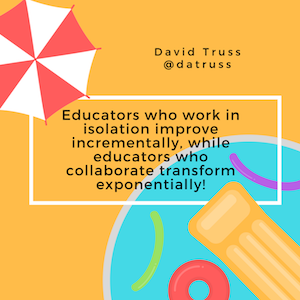“Educators who work in isolation
improve incrementally,
while educators who collaborate
transform exponentially!”
I said this in a Twitter Chat a few days ago in response to the question:
“Why do you believe that a shared vision and belief system is important to transform education?”
This was one of the Twitter Chat questions posed by @Kathleen McClaskey.
The #PLearnChat (the Personalize Learning Chat) topic was Summer Book Study – Ch 1 & 2, for Barbara Bray and Kathleen McClaskey’s book How to Personalize Learning: A Practical Guide for Getting Started and Going Deeper. This is a great book, that I had the opportunity to review, “…teachers can pull key components and activities out and use this book to enrich what they are already doing to meaningfully engage learners…”
~~~
Teachers working in isolation, at best, will improve incrementally.
Teachers who collaborate, learn from each other. They will feed off of each other’s insights and enthusiasm and they will learn exponentially. If they participate in collaborative learning opportunities with peers and students, they will see exponential growth in student learning as well.
The era of educators as lone experts in the front of a classroom is over. But the era of networked learning and collaborative opportunities (both in face-to-face and digital communities) is just beginning. Actually it has been around for well over a decade, but a critical mass is in reach, and educators who chose to stay isolated will be left behind.
This is a paradigm shift that ‘favours the connected mind‘. Good ideas take time to evolve and educators with an innovative mindset understand the power of being collaborative.
~~~
Here is a posterized version of the quote, shared by Kathleen in a Tweet and on the Personalized Learning website.
~~~
Q3. Why do you believe that a shared vision and belief system is important to transform education?#plearnchat
— Kathleen McClaskey (@khmmc) July 6, 2017
~~~
A3. Educators who work in isolation improve incrementally, while educators who collaborate transform exponentially! #plearnchat https://t.co/tUJkf2J91o
— David Truss (@datruss) July 6, 2017
Update: New poster made by Michael Buist
Thinking of all the ways my teammates can work collaboratively during these strange times. @datruss #ColtsMath pic.twitter.com/85tCx2fP8W
— Michael Buist (@BuistBunch) March 29, 2020
~~~
Enjoyed this read? Like my Facebook page… Get my monthly newsletter… Or share with the buttons below.
Also published on Medium.


Wonderful idea to chew on. I have been considering how social media allows up to connect to “like-minded” individuals and how the larger challenge may be that co-worker whose classroom is beside ours and who may not have the same vision and belief system we do. While digital communities can be powerful, how much more so are face-to-face, everyday collaboration! How might we further break down those walls (literally and figuratively!)?
I have also begun to see how collaboration outside of education can be powerful. While others may share the same vision and beliefs, they don’t have the same assumptions and perspective. Generally, I have found bringing outsiders in (face-to-face and digitally) to be quite transformation. Have you come across nepris.com?
Excellent points Shaun, and great to connect here… it has been a while since we chatted.
Collaboration ‘beyond our walls’ is something I want to focus on this year at our school. It has happened to a small extent informally, but I think it takes effort to make it happen in a systematic way. Any good collaboration requires a common understanding of expectations, or the same differing perspective and assumptions that you mention as positively adding to the transformation, can instead become roadblocks.
Thanks for the link to explore!
Dave